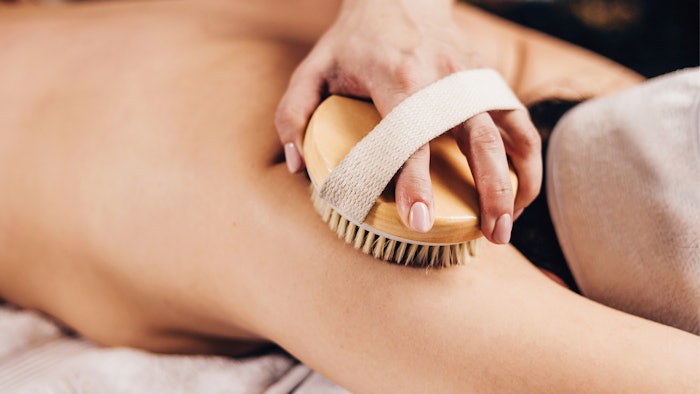
Dry body brushing is a versatile service that may be implemented in several different ways in the spa environment. Most frequently, it is the first step in body wrap treatments, preparing the skin prior to salt or sugar exfoliation.
Used as an add-on, dry brushing can be offered all year or seasonally, or even for free as a promotional addition to other body services. After all, it is extremely cost effective to perform.
For example, you can create a seasonal summer package of two simple, hydrating, pre- and post-vacation body treatments, with dry body brushing added on for free. This offers great retailing opportunities too.
Dry brushing is a wonderful add-on to massages, as well, especially if essential oils or other therapeutic botanicals are involved. By removing the outermost layer of keratinocytes, you make the skin more receptive and able to absorb subsequent products. Similarly, it can be used prior to sunless tanning to slough off dull surface skin cells.
Related: Polished Perfection: Benefits of Body Scrubs
Dry Brushing Prep
Body brushing is best performed on dry skin to ensure the sloughing of dead cells. A light pressure is ideal for lymphatic stimulation, and medium pressure works best for exfoliation. If the skin turns red, it’s a sign that too much pressure is being applied; this can potentially damage the epidermis and pre-sensitize the skin.
Even well-versed spa regulars may not have experienced dry brushing before, so it will be useful to explain beforehand that you’ll be including dry brushing in the service. Demonstrate the process on the client’s forearm before you begin the treatment to put them at ease and remove the element of surprise.
In addition, there are many types of body brushes available. Some have long handles, short handles and even no handles at all. For professional treatments, short or no handles are best for giving the therapist control. Long handles work better for home use, so clients can access harder to reach areas.
Brushes also vary greatly in bristle firmness—soft, medium and firm. If the bristles are too soft, you won’t achieve much exfoliation; if they are too firm, they can feel scratchy and uncomfortable. Medium firmness is the way to go, allowing practitioners to vary pressure when working on clients with different sensitivity levels, as well as on different parts of the body where skin thickness varies.
When deciding how much to charge, keep in mind that there is no cost of product, as it will be added to an existing service. That also means no additional costs related to laundry or room turnaround time need to be added. Calculate your general cost for a 60-minute treatment and divide it by 4; charge that for 15-minute dry brushing add-ons. For a 30-minute protocol, you would simply double that number.
Gaynor Farmer-Katics is passionate about teaching estheticians how to refine their touch by increasing their repertoire of massage techniques. With almost 40 years of industry experience as an esthetician, massage therapist and educator, her business Enhanced Touch (www.enhanced-touch.com) offers both online and in-person training.












